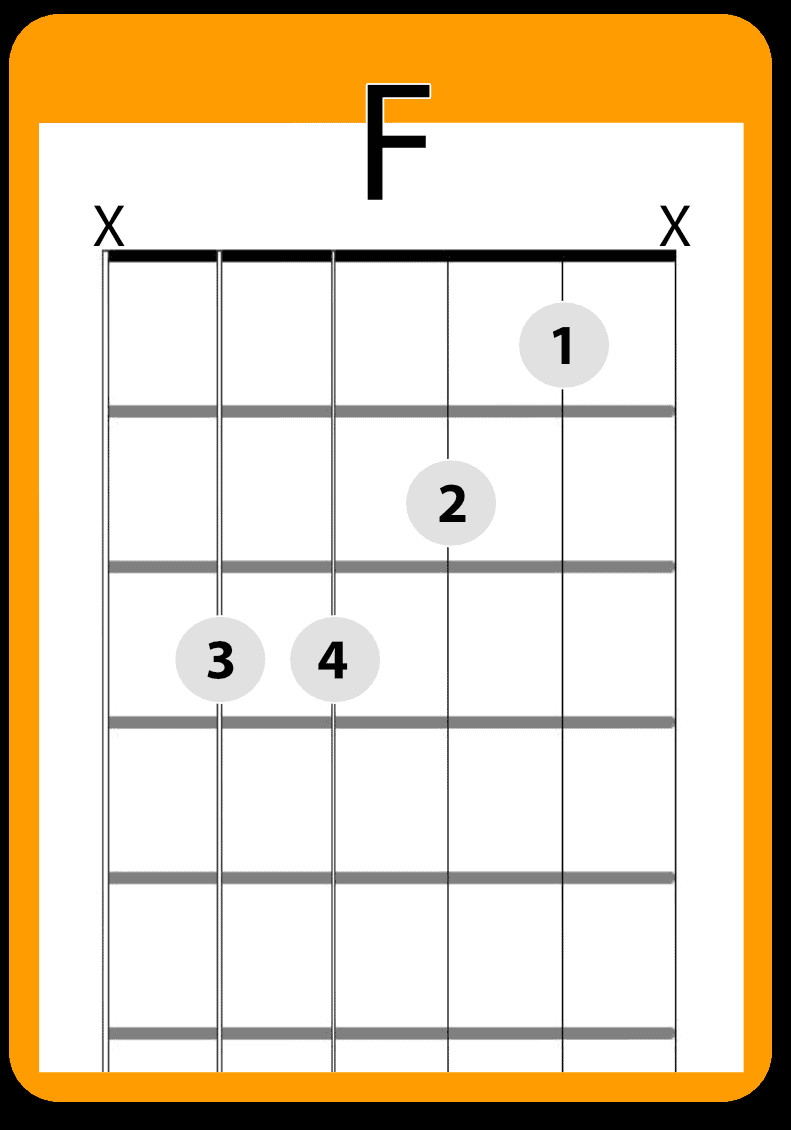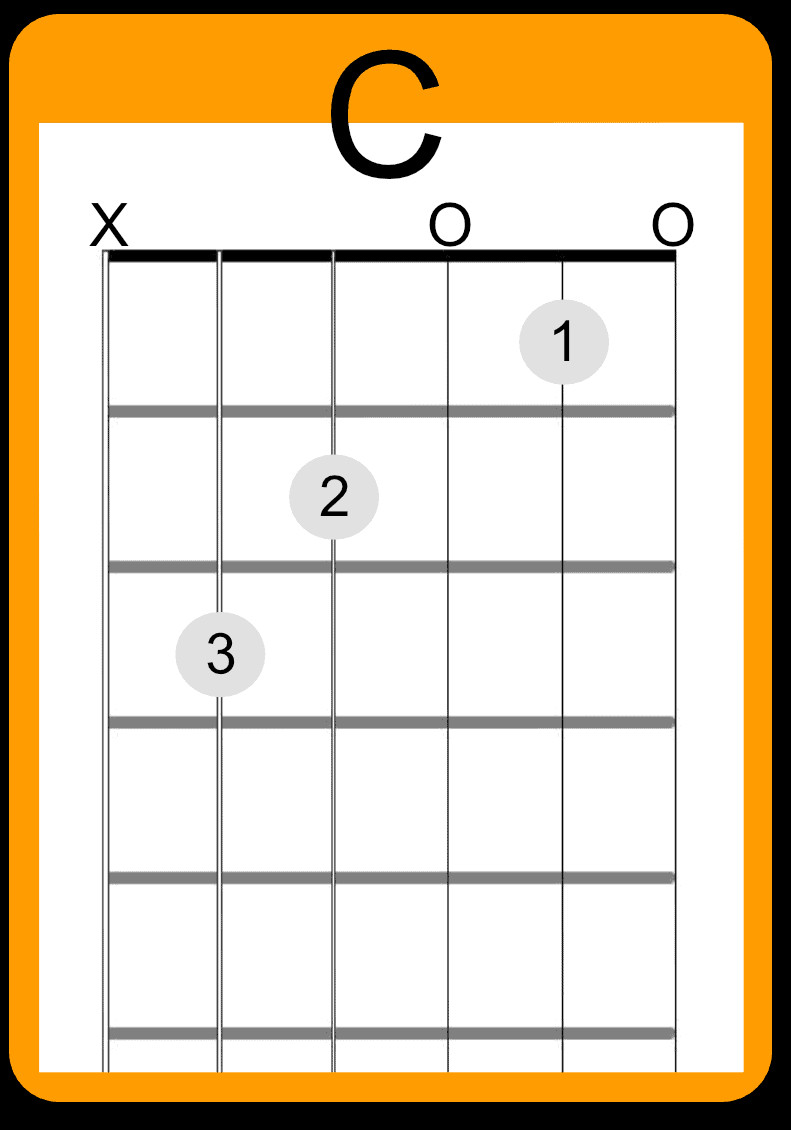Is the F chord standing between you and your favorite songs? You’re not alone. Many popular songs rely on the F chord, making it essential to learn. But don’t worry!
This guide will show you a simple, beginner-friendly version of the F chord for guitar. It sounds great and doesn’t require any barre chords. In fact, if you can already play a C Major chord, you’re almost there. Ready to unlock the easy F chord? Let’s get started!
 Diagram showing how to play the easy F chord on guitar, an open position voicing perfect for beginner guitarists.
Diagram showing how to play the easy F chord on guitar, an open position voicing perfect for beginner guitarists.
Let’s learn how to form this easy F chord, starting from the highest strings down. Place your index finger on the 1st fret of the 2nd string (B string). Next, use your middle finger to fret the 2nd fret of the 3rd string (G string). Finally, your ring finger and pinky finger will cover the 3rd fret of the 5th (A string) and 4th (D string) strings, respectively.
When playing this simplified F chord on your guitar, you’ll only strum from the A string (5th string) down to the B string (2nd string). The low E string (6th string) and high E string (1st string) are not played in this voicing of the chord.
To ensure a clean sound, you can gently mute the unused strings with your fretting hand. I like to lightly touch the high E string with the tip of my index finger and the low E string with my ring finger to prevent them from ringing out. Alternatively, you can focus your strumming to avoid hitting those strings altogether. Many players, including myself, use a combination of both muting and careful strumming.
Does This Simple F Chord Sound Good Enough?
You might be wondering if this simplified F chord will really sound good. You might be thinking, “Will this easy version truly work? Will it sound anywhere near as full and rich as the standard F barre chord?”.
The answer is a resounding yes! For proof, listen at 2:01 in the video. You’ll notice that the difference in sound between this easy F chord and the full barre chord is minimal. While there might be a slight tonal variation if you listen closely, in the context of strumming chords in a song, the difference is practically unnoticeable.
(Important Note: This concept of “easy chords” isn’t just about simplifying barre chords. This easy F chord is a different “voicing” of the F chord. Musicians often intentionally use different voicings or variations of chords to add color and texture to their music!)
Practicing the Beginner F Chord on Guitar
 Diagram showing the C major chord in open position for guitar, a foundational chord for beginners.
Diagram showing the C major chord in open position for guitar, a foundational chord for beginners.
 Diagram showing how to play the easy F chord on guitar, an open position voicing perfect for beginner guitarists.
Diagram showing how to play the easy F chord on guitar, an open position voicing perfect for beginner guitarists.
Knowing how to finger this easy F chord is only the first step. You need to be able to switch to it smoothly and automatically. I’m going to share a highly effective practice method to help you achieve this. This method is effective for two key reasons:
Firstly, it uses a chord progression you’ll frequently encounter in countless songs. You’ll be practicing chord changes that are highly practical and widely applicable.
Secondly, it utilizes a technique I teach in my Real Guitar Success Academy called Common Chord Fingers. This approach streamlines chord changes and makes learning faster and more efficient.
Here’s the practice routine:
-
Start with a folk-style C chord. Refer to the chord diagram above. This is a standard open C Major chord, a fundamental chord for any guitarist.
-
Transition to the easy F chord. Now, keeping your index and middle fingers in place, simply move your middle finger up one string to the 3rd string (G string, still at the 2nd fret), and bring your pinky finger down to the 3rd fret of the 4th string (D string). You’ve now formed the easy F chord!
-
Identify the Common Chord Fingers. Notice that your index and middle fingers (marked blue in the diagrams) remained in the same position during the C to F chord change. These are your “Common Chord Fingers.” Let’s now move back to the C chord, again keeping those fingers planted.
-
Practice the transition slowly. Repeat the C to F and back to C movement several times without strumming. Focus on getting the feel of the finger movements and ensuring accuracy.
-
Incorporate strumming at a slow tempo. Strum the C chord twice, then smoothly transition to the F chord, maintaining your Common Chord Fingers throughout the change. Practice with a steady rhythm, using a metronome at a slow tempo to build timing. Your goal is to change chords cleanly and on time without pausing or slowing down.
-
Increase the tempo gradually. Once you can confidently switch between C and F with two strums per chord, move to one strum per chord. Strum each chord once and then change.
-
Further accelerate your progress. Gradually increase the metronome speed in small increments as your chord changes become smoother and faster. Consistent practice is key to improving your chord changing speed.
Practice this exercise for a few minutes each day, and you’ll quickly master this easy F guitar chord.
Final Thoughts on the Easy F Chord for Guitar
There’s one more crucial point to consider. While this easy F chord is incredibly useful and can replace the barre F chord in many situations, learning barre chords still holds significant value. The primary reason is the versatility barre chords offer – you can play them anywhere on the guitar neck, allowing you to play different inversions and voicings of the chord in various musical contexts.
The F barre chord, specifically, serves as an excellent entry point into learning barre chords in general. It helps you understand the mechanics and principles behind barre chords.
Here’s a quick tip to expand upon the easy F chord and transition towards a partial barre chord: While holding the easy F chord, simply flatten your index finger to fret both the 2nd string (B string) and the 1st string (high E string) at the 1st fret simultaneously. This creates a partial barre. The next step would naturally be to learn the full F barre chord, but that’s a topic for another video (and perhaps two, or even three).
Thank you for joining me! If you found this lesson helpful, please subscribe to my YouTube channel and leave a comment below – I love hearing from you. If you’re ready to take your guitar playing to the next level, check out my Real Guitar Success Academy. We have comprehensive courses, including dedicated modules on mastering barre chords. I hope to see you there!
Save This Lesson For Later!
 Collage image for Pinterest, image one in a series of three designed for social media sharing.
Collage image for Pinterest, image one in a series of three designed for social media sharing.
 Collage image for Pinterest, image two in a series of three designed for social media sharing.
Collage image for Pinterest, image two in a series of three designed for social media sharing.
